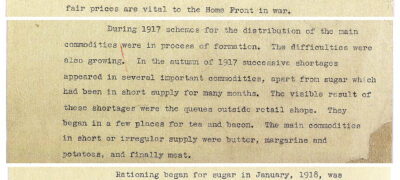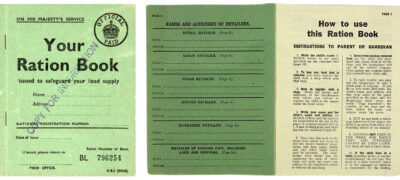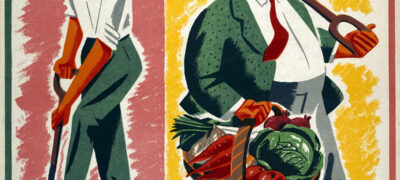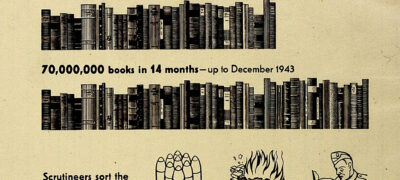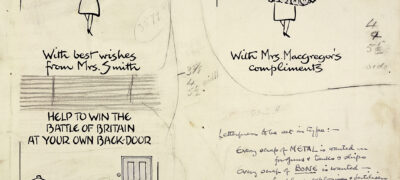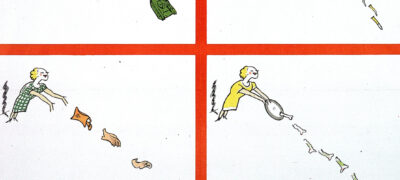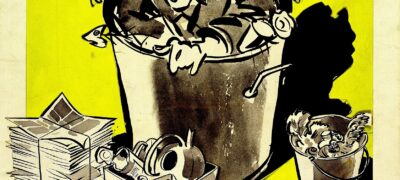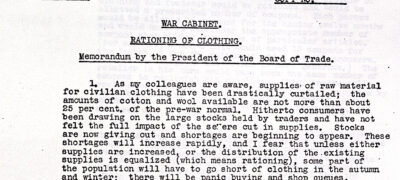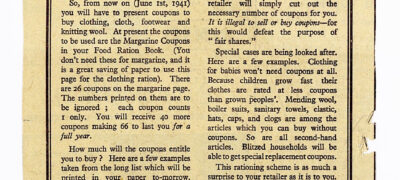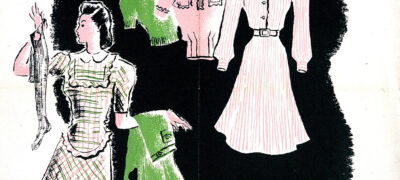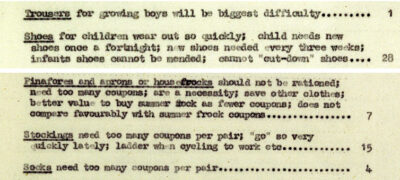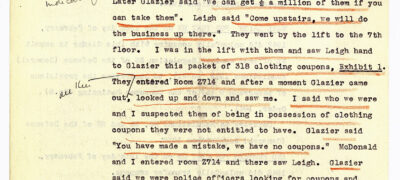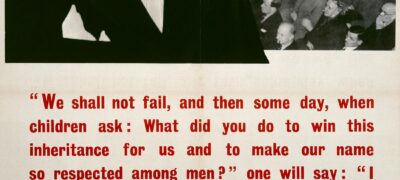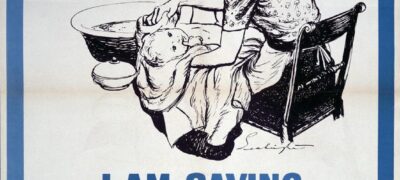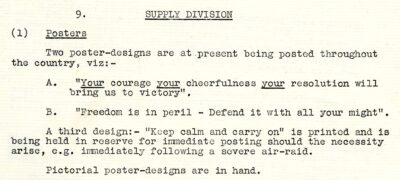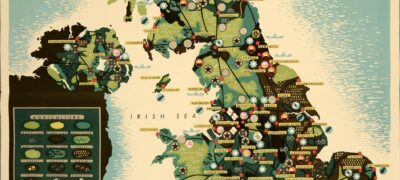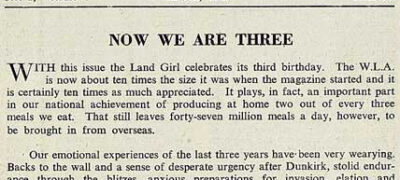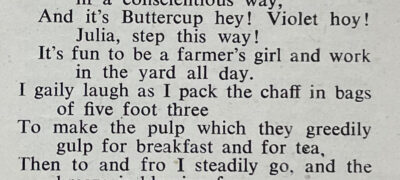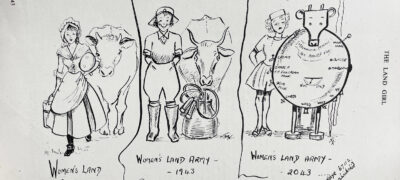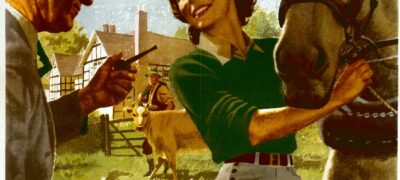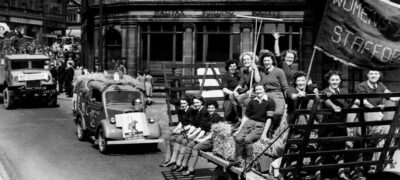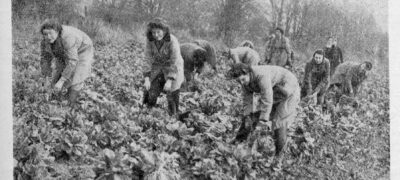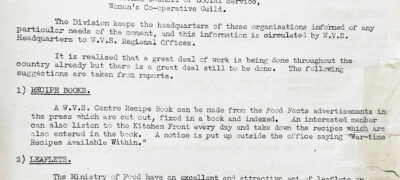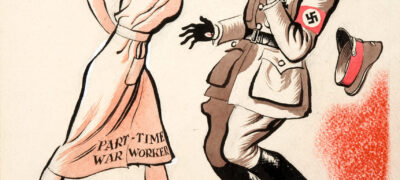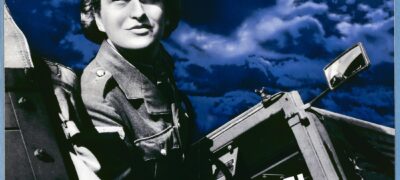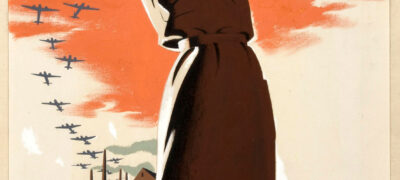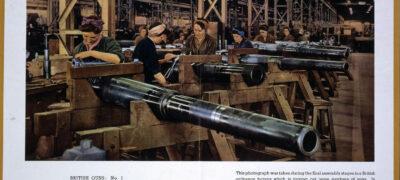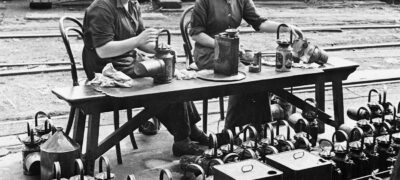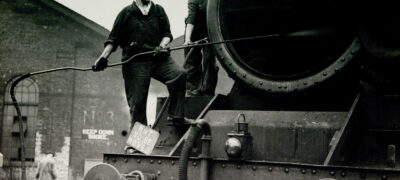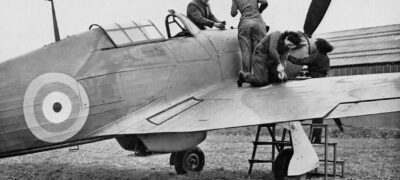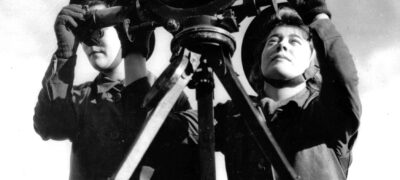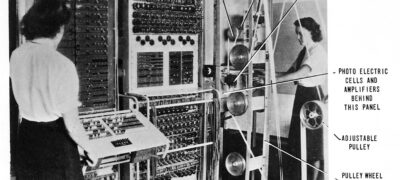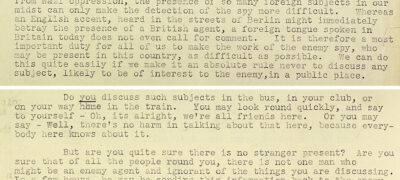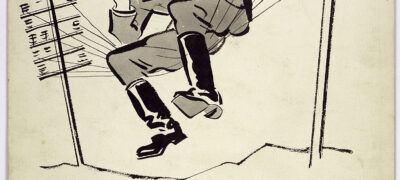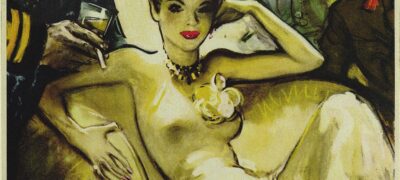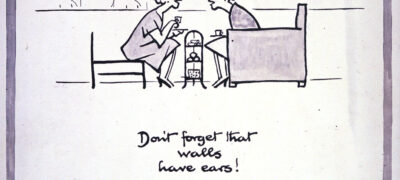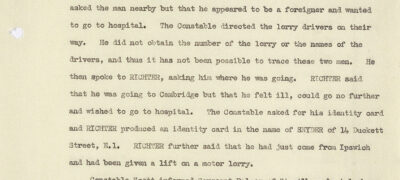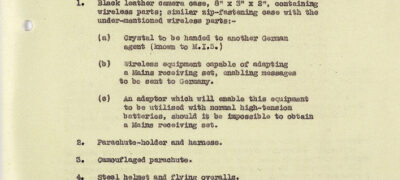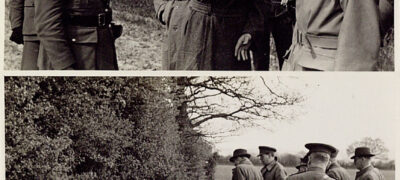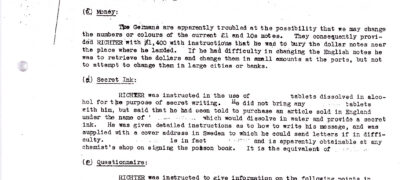Download documents and transcripts
Teachers' notes
The purpose of this document collection is to allow students and teachers to develop their own questions and lines of historical enquiry on the political and social aspects of the Home Front, 1939-1945. The documents themselves are arranged according to theme, so that sources are grouped together rather than following a strict chronological order.
To accompany both collections of documents, we have linked to a collection of original films from the Imperial War Museum about life on the Home Front. We provide questions on these films and there is also a task outlined below:
Watch a film and discuss/answer the questions:
- Select 3 to 5documents from either Home Front collection to show how they can be used to support the message and content of one or more of the films.
- Write a report/record a video to explain your choice of documents.
- What are the advantages of using public information films like these with document sources as evidence for life on the Home Front?
There are three themes covered in this collection (Part 2). We have provided questions/tasks for some of the sources in each theme. Please note that there are not questions for every source, except for those indicated in these notes. Some questions however link to other referenced sources in the collection for learners to explore at the same time. The questions can also be found on the relevant source pages for convenience with additional notes to provide context.
1. Everyday Life: rationing; salvage; ‘make do and mend’; black market.
Document: Notes on the need for food control and the reasons for rationing Catalogue ref: INF 1/343
- What two reasons made rationing necessary according to the Government?
- Take a look at the ration book, Catalogue ref: BT 131/40. Can you explain how the ration book was used?
- How and why were people encouraged to grow their own food in the poster: Catalogue ref: INF 3/97?
Advertisement: Board of Trade explains reasons for clothing rationing: Catalogue ref: BT 64/3026
- How does this source explain that rationing meant ‘fair shares for all’?
- What were the findings of an investigation into attitudes towards clothes rationing, Catalogue ref: BT 64/4101?
- What was the Black market? See source on the illegal sale of coupons, Catalogue ref: CRIM 1/1387.
Poster: Poster illustrating how salvage would help Britain defeat Hitler, Catalogue ref: INF 3/203
- Can you explain how words and image are used to persuade people to not waste metal and paper?
- Look at the poster designed by Fougasse (Cyril Kenneth Bird) used in the salvage campaign, Catalogue ref: INF 13/148
- What is the message of this poster?
- Which of these salvage posters is more effective in your opinion?
- Why were people encouraged to salvage books during the war? Catalogue ref: INF 2/47
- How could the book campaign be used to help keep up public morale?
- Can you explain the connection between this ‘Make do and mend’ poster and the War Cabinet memorandum on the rationing of clothing, 1941, Catalogue ref: PREM 3/96/1?
- Why are women targeted in this advert ‘Watch Your Meters’ poster Catalogue ref: INF 13/299 (31)
2. Women at War: Women’s Land Army; women’s voluntary services; women in factories.
Recruiting poster: for the Women’s Land Army, Catalogue ref: INF 13/140/19
- Can you explain how words and image are used to persuade women to join the Land Army?
- Why did the government want women to join the Women’s Land Army?
- Do you think it provides a realistic picture of work on the land? Explain your ideas.
- Why could the Women’s Land Army not rest in 1943? What were they trying to do according to ‘the Land Girl’ magazine? Catalogue ref: MAF 59/22
- What does the poem called ‘A land girl’s day’ and the cartoon called ‘Women’s Land Army’ reveal about the life of a land girl?
- Why do you think the Ministry of Agriculture did not use this photograph of women gathering cabbages as a poster to recruit for the Land Army? Catalogue ref: MAF 59/22
Document: Women’s Voluntary Services for Civil Defence (WVS), Catalogue ref: MAF 102/11
- What does this source show about importance of women in the organisation of the government’s wartime food campaign?
- What general support did the WVS provide on the Home front?
Photograph from Ministry of Information showing women at work, Catalogue ref: INF 2/8
- What work are women doing in this factory to contribute to the war effort?
- How is this government poster encouraging women to work in factories? Comment on the words and image used. Catalogue ref: INF 3/403
- How is this government poster encouraging women to join the ATS (Auxiliary Territorial Service)? Comment on the words and image used. Catalogue ref: INF 13/42
- Find four sources showing different jobs carried out by women during the Second World War.
- What is the message of this recruitment poster aimed at women? Catalogue ref: INF 3/400
3. Spies: campaign addressing careless talk; the case of Karel Richter.
Poster: ‘Keep Mum, she’s not so dumb!’ Catalogue ref: INF 13/217/20
- The men in this poster are wearing uniforms. Can you identify which of the armed forces they are serving in?
- Do we have any clues who the woman is? What do you think she could be?
- Who is the poster aimed at? What is its message?
- Do you think this poster would be used today? Give reasons for your answer.
- Look at two other posters: ‘Be careful what you say’ Catalogue ref: INF 3/232 and ‘Don’t forget walls have ears!’ Catalogue ref: INF 13/217/28. How do these posters deliver the message about the dangers of careless talk?
- Which of the three posters featured in this collection is the most effective? Explain your reasons for choosing it.
Document: Extract from a report giving details of spy Karel Richter’s mission Catalogue ref: KV 2/31
- What was Karel Richter sent to Britain to do?
- Why do you think Richter was asked to collect information on roads, railways, gas masks and identity cards?
- Why would Nazi Germany want this kind of information?
- Why was Richter told to change the money he was given at ports rather than in large cities or banks?
- Part of this document has been kept secret. Can you think of a reason why it has been kept secret?
- How much damage would Richter have done if he had achieved his mission?
- Read the MI5 account of the capture of Karel Richter, Catalogue ref: KV 2/32. What makes the policeman suspicious of Richter?
Document: Extract from the case file on the interrogation of Karel Richter, Catalogue ref: KV 2/32
- How does the MI5 Officer describe Karel Richter? Why does he think this?
- Why does Richter decide to admit that he was a spy?
Look at the list of items found in the field. - Which items would be of no more use after Richter had landed?
- Which items would Richter have needed to carry out his mission?
Students could work with a group of sources or source type on a certain theme or linked themes. The documents should offer them a chance to develop their powers of evaluation and analysis and support their course work. Alternatively, teachers may wish to use the collection to develop their own resources or encourage students to ‘curate’ their own ‘exhibition’ of the most significant sources on the topic.
Please note that content in this themed collection has been redeveloped from content in our Home Front 1939-1945 focussed topic website which has been archived as the interactive parts no longer work.
Connections to curriculum
Key stage 4
Edexcel GCSE History
C 1900– present: Warfare and British society in the modern era
Experience of war: The impact of war on civilians, including recruitment and the organisation of a Home Front during Second World Wars. Government use of censorship and propaganda in wartime.
The historic environment: London and the Second World War, 1939–45
OCR GCSE History
The First and Second World Wars: the beginnings of ‘total war’, including the impact on people’s lives, increased state power and the changing relationship between the state and the people.
Key stage 5
AQA GCE History
The People’s War and Peace, 1939–1951
The social and cultural impact of ‘total’ war: conscription; women and children; civil liberties and restrictions; propaganda; the Blitz; plans for reconstruction including Beveridge and the Butler Act; policies of post-war Labour government, including the creation of the NHS and medical advances
Introduction
Home Front 1939-1945: Fighting the war at home.
Britain had always prided itself on its island position which made it feel safe from assault. However, around a third of Britain’s food was imported via ships, meaning that the food supply was vulnerable to attack from the air or by sea.
Sir William Beveridge, the Minister of Food, knew that Britain had to be as self-sufficient in food as far as possible. So pasture must be ploughed up and crops such as wheat, corn, barley planted. Farmers were encouraged to turn from raising cattle to sheep because most cattle feed came from abroad whereas sheep grazed on grass.
A number of British farms were inefficient, using old machinery and methods that had not changed in decades. Such farms were requisitioned and – harsh but necessary – the tenant farmers evicted, to be taken over by the Ministry of Agriculture.
At the other end of the chain was consumption, which needed to be controlled and food distributed fairly among the population. Therefore, in January 1940 the issuing of ration books with coupons came into effect. Different food stuffs required a certain number of coupons and this changed according to the season and availability of items. So, it was pointless to take a shopping list, you could only buy what was available. The government tried to help with leaflets and broadcasts giving suggested recipes. Predictably the system did not always run smoothly and there were complaints that men needed more meat because of the heavy work they did.
Though Prime Minister Winston Churchill initially warned that rationing clothes was a measure too far and would lower morale, on 1st June 1941 clothes rationing followed. The move was kept secret until the last minute in an attempt to avoid panic buying. Women tackled the problem with ingenuity. Bedspreads were turned into dressing gowns and the wool from knitted garments was unravelled and re-knitted into warm jumpers for use at home or by fighting men. Women could only buy very plain clothes: frills, pockets and lace trimmings were forbidden and skirt lengths shortened. Men’s suits were made or altered to have very narrow lapels; trousers were shortened as much as they could be without the wearer feeling ridiculous.
The purchase of many other goods was restricted too. Wood was needed to construct and repair planes and for other urgent military purposes, hence the introduction of utility furniture, characterised by the absence of fussy decoration in its design. It looked pleasingly like modern Scandinavian furniture! Rationing was very gradually reduced after the war, but it was not until 1954 that the final foodstuff, meat, was no longer ‘on the coupon’.
Another fundamental shift in society was in regards to the role of women. Despite being American, the ‘Rosie the Riveter’ poster was an iconic symbol of the shift in cultural attitudes towards women. With her hair pushed back under a scarf, and her strong muscular arm holding a spanner, the picture was an encouragement for women to do whatever it took to help the war effort.
Women were never conscripted to fight, however their contributions to maintaining morale on the home front during these tumultuous years, as well as their service in the Land Army, amongst other organizations, was invaluable. At its peak in 1944, there were over 800,000 ‘land girls’ who engaged in a variety of jobs on the land – driving tractors, killing rats and various other unpleasant roles.
Government propaganda served as a way of persuading people to support various home front campaigns to help win the war. Eye catching posters and leaflets with sharp messaging were produced by the Ministry of Information on a huge array of topics including the dangers of ‘Careless talk’, the need to ‘Dig for Victory’ or ‘Make do and mend’ and others. This information was displayed in shops and shop windows, council buildings and village halls. The Ministry of Information also made films and radio broadcasts to bring its messages home and you can watch some of the films with this document collection. Some of the nation’s most significant artists, cartoonists and film makers produced work for the Ministry of Information.
Despite the destruction of the war, Britain slowly managed to reconstruct the country, and the informal contract between the people and the government began to be realised with the formation of the welfare state.
Juliet Gardiner, author: ‘The Thirties’; ‘Wartime Britain’; ‘Joining the Dots: A Woman in Her Time’.
External links
- For further sources search the collections at the Imperial War Museum
- Find a wealth of visual material on the Art of War
- Find out more about life on the Home front from National Museum of Scotland
- National Archives blog on civilian honours during Second World War
- National Archives blog on the Home Guard
- National Archives blog on women in Second World War art
- National Archives blog on the Beveridge Report 1942 and foundation of the Welfare state
